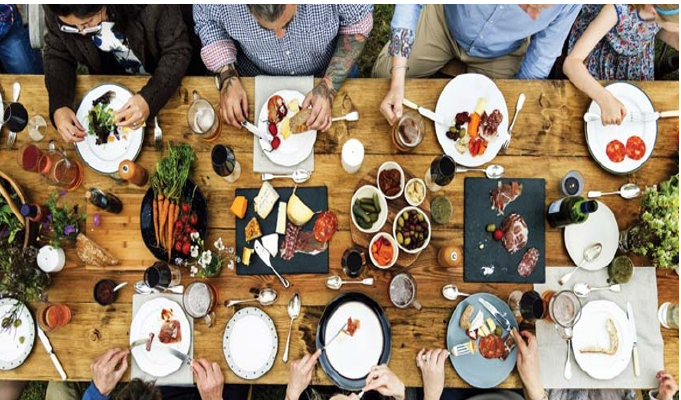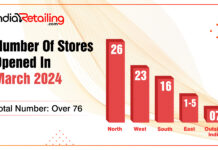Food has always been an integral part of our culture and each region of the country has its unique cuisine deeply rooted to its traditions, lifestyles, religions, climates and agricultural conditions. However, as we are witnessing, each new generation is ushering socio-economic and cultural changes and this is now reflecting in their overall behaviour, including food habits. The shape, size and construct of food industry is thus changing. This evolution is further supported by continuous improvements in the food supply chain inclusive of product development, production, processing, distribution and marketing.
Indian consumers, comprising the largest Gen Y population in the world with a median age of 27 years, are more experimental by nature, more inclusive and inter-mingling with different cultures and social structures. At the same time, they suffer from time poverty but have enough money to spend, having started to earn at a much younger age and, hence, they are more inclined to spend on better and more aspirational things in life. The ‘New Indians’ want to live their life well and have a deep desire to impress/ influence peers and to be influenced by them, living in a highly connected social structure. These attitudinal and behavioral changes are reflected across all categories, specifically food, which has the largest share of the Indian consumer’s wallet.
Further, with the Indian economy expected to grow at almost 8 percent over the next decade, per capita income will also increase. Increasing wallet sizes will result in an increased ability to pay as well as the willingness to spend. As a result, the per capita food and beverage expenditure of Rs 18,200 in 2016 is expected to grow at 10-12 percent CAGR over the next decade. Subsequently, the total food and beverage consumption expenditure of Rs 24 lakh crore in 2016 is expected to grow at 12-14 percent CAGR over the same period.
The changes in Indian consumer and economy are explicit and so is the impact of these changes on the food market. For retailers as well as brands, this means a great deal. The aforementioned macroeconomic and attitudinal changes will drive the food consumption trends giving rise to significant business opportunities.
Wazir has identified six key consumption trends that will shape the future of Indian food market and present significant opportunities for new as well as existing businesses.
1. Widening Palate, Yet Strong Regional Preferences in Food
The story of urbanization in India is different from the rest of the world. The migration to urban centers in India is not happening as fast as it happened in China and is not limited to a few large cities as it happened in South Asian countries like Thailand or Indonesia. In India, it is the middle-tier or lower tier cities that are expected to see maximum population growth over the next decade, driven by migration from smaller towns and villages in the same region.
This augurs that consumer food preferences, though evolving, will still pre-dominanatly remain very regional and localized, while the palate will widen. Thus, there will be a heightened opportunity in making packaged and branded options in regional foods available to the consumers. The good news is that not only will the people from that specific region consume it, but those from other regions as well will try, driven by the need to experiment.
Companies that can modernize, traditional regional foods/ recipes, making them more convenient to use/ consume will emerge as winners and the potential is immense. A case in point is Hector Beverages which, with its innovative twist on traditional drinks, has created a niche market for itself. As a result, the company achieved a CAGR of more than 75 percent in revenue for the period 2013-16.
2. Urbanisation and Time Pressures are Fuelling the Rise of Convenience Foods
Due to urbanization, the working population size across different city tier types is increasing and the types of occupation that the residents are indulging in are also changing. Further, urbanization is resulting in the rise of nuclear households and increase in the women workforce. All these shifts translate into a lifestyle with lesser time availability and the subsequent willingness to spend lesser efforts on food preparation, resulting in increased consumption of processed convenience foods. Supported by increasing incomes, the working population is thus evolving from traditional food habits to accepting, adjusting and adopting modern urban food habits. The steady decline in per capita consumption of cereals, staples and pulses in recent years is a testimony to the same and consuming processed convenience foods has become part of the modernization process.
Convenience foods, being true to their name, are ready to eat/ drink or require minimal effort to cook, thus taking off the pressure to prepare a meal. In India, these foods are not yet used in the same manner or scale as in western food habits. However, these foods are successful in carving out their niche in the lives of Indian consumers and their adoption is increasing every day, driven by time pressures and an increasing urge to experiment and try out new things.
At present, the majority of categories in convenience foods is growing at 15 percent+ CAGR. Except for a few categories like dairy, there exist very few pan-India brands in others. Given the scope of opportunity, many of these categories could prove to be the biggest expansion opportunity for businesses, which can dare to think different and large scale.
Many product categories also present a large opportunity due to the consumer shift from unpackaged to packaged and unbranded to branded items. As an example, the Indian sweets category, with an estimated market size of Rs 80-90,000 crore, is the biggest organized player in the category with less than 1 percent share of the market. This presents a huge potential for multiple players to co-exist in the market. Snacking is another category where many companies have come up in the last few years and there is still space for many more. The convenience foods category is innovation and product development led and will be cornered by players who can maintain a quality-price equilibrium.
3. Portionization is All Set to Gain Traction
The consumer buying behaviour in urban and rural India varies significantly. Functional, emotional and affordability factors translate to the choice of products and the pack sizes being bought at the respective places. However, portionization is a common trend that will gain traction going forward.
In urban India, particularly in metros and tier 1 cities, consumers are becoming not just cautious about what to eat, but also how much to eat. There is a continuous dilemma between the need to indulge and the guilt of indulgence. As a result, consumers are increasingly opting to buy multiple smaller portions/ packs to control calorie intake per occasion. At the same time, led by the quick onset of boredom, there is a high willingness to switch to/ try all available choices/ variants. Therefore, the portionization trend is visible across all indulgent food categories in urban India and will spread to other categories soon. This will also be supported by the consumer’s need for ‘to-go’ packs, which can be eaten from while travelling to office or other places.
In rural India, where consumers are still transitioning from unbranded to branded products, every purchase is evaluated in terms of value associated with the product resulting in smaller packs becoming more and more relevant. Subsequently, all key packaged food players particularly in beverage and snacks segments, are offering smaller versions of the larger packs to gain deeper penetration and higher acceptance.
While portionization is starting to gain importance due to its salience across consumer segments, rising ‘individualism’ and preference for what ‘I like’ as against what ‘we like’ will further strengthen the case. As an example, in ice-creams and frozen desserts, individual impulse single packs are growing and take home packs have been shrinking in consumption. The share of take home packs has decreased by 2 percent in the last 4-5 years and is projected to decrease further.
Further, many players across categories (e.g. Kellogg’s in breakfast cereals, ITC & Unibic in cookies, etc.) have started bundling multiple individual packs of various variants in a single pack for consumers to try out different flavors and not get bored, while catering to the varying preferences of the families.
4. Gourmet: A Food Whose Time Has Come
The gourmet foods market took its time to establish, but is now soaring in India. The market, which is characterized by distinctly flavoured, high quality, fresh and beautifully packaged food products, stands at Rs 15,000 crore and is growing at a CAGR of 20 percent. The biggest buyers of gourmet foods are the urban/ metro residents who understand the finer nuances and aspects of foods as they are well travelled, well versed with fine foods, possess a refined palate and seek experience.
At the same time, cooking channels, reality cooking shows, food bloggers and food entrepreneurs are directly or indirectly supporting the gourmet food phenomena by educating more and more urban consumers about new cuisines that they can cook and eat at home. There are more than 150 food shows across Indian channels and quite a few rake very high TRPs. There are a multitude of food bloggers supported by food photographers who make it look even more exquisite. There is food tourism and ‘passion trails’. Food entrepreneurs are trying out gourmet trucks, inspired by the ‘Eat Street’ and cooking classes are thriving, thanks to the enthusiasm stirred up by TV chefs. Food-related TV programs have spawned a cooking cult in India, and Nigella Lawson, Donna Hay and Gordon Ramsay are the talk of the town.
In line with the global trend, this culinary adventure is creating a whole new market for exotic food products and professional kitchen equipment. Gourmet home cooking has become fashionable and something that consumer want to flaunt in a socially connected world.
To leverage the potential, key retail chains are constantly revamping their product range. The idea is to maintain a product range that is forever unique, exotic and authentic. As an example, currently, Foodhall product range includes tomatillo to gluten-free breads such as pizza dough, bagels to greek yoghurts, organic milk, tofu to gourmet chocolates, oils & vinegars, teas, mock meats and specialty cold cuts. The current product range is expected to see constant product additions as well replacements.
Instead of limiting themselves to key retailers, many gourmet brands are also recruiting new consumers by making their products available at select supermarkets, local food stores, etc. These brands are breaking the myth of gourmet food being considered as just an organized retail chain product. Such brands are hence growing faster than the market.
In the years to come, gourmet foods business will become more democratic. This is because, in order to capitalise on the rapidly growing consumer acceptance, brands will have to strive for price betterment, new product launches and geographic coverage. While one side of this market is being serviced by imports, on the other side many Indian companies/ entrepreneurs are now setting up manufacturing units for niche gourmet foods and are finding good demand in metros and in the hospitality sector.
5. Health And Wellness Foods To Be Driven By Awareness, Acceptability And Trust
With rising awareness, a section of consumers has moved beyond the basic functionality associated with the food products. These consumers are seeking higher value or enhanced functionality to seek better health benefits. They are seeking food products with incremental nutrients, chemical free or organic ingredients, natural flavors, added fibres, low fat content, etc., and are also willing to pay the premium for these, supported by increasing earning power and the increased willingness to spend on oneself.
This trend is manifesting in two ways. Firstly, there is an increasing trend amongst companies to add healthier options in their products range – e.g., companies selling staples and pulses are introducing polish free pulses, multigrain atta variants etc.; those in juices are adding cold pressed juices; those in biscuits and baked products are introducing multi-grain biscuits, ragi cookies and the like. ITC has just launched Farmland, a range of packaged vegetables, starting with low sugar potatoes with natural antioxidants. Organized retailers have been allocating incremental shelf space to healthier options within the standard food categories each year and these now contribute about 10-20 percent of sales across various retailers.
Secondly, there is a high growth in certain pure play health and wellness foods categories. While the overall market currently stands at Rs 10,350 crore and is growing at 10-11 percent CAGR, there are many product categories that are growing much faster and are successfully replacing the traditional food options due to negative health impacts associated with them. These include green tea (50 percent plus CAGR), oat based products (15 percent plus CAGR) etc.
With the presence of very few brands, new entrants will stand a fair chance to leverage on consumer awareness, develop acceptability and garner trust. However, this opportunity needs to be catered with the right product and right packaging, which communicates the benefits profoundly to consumers. The recent growth of companies like Organic India, 24 Mantra, etc. Reflects consumers’ willingness to move to healthier options at a premium.
6. Online Food And Grocery Retail Is Here To Stay
Indian consumers are starting to live in an internet-based world, which is enabling them to have an online shopping experience across categories. The same is also happening for food and grocery, which is yet to realize its true potential with Indian consumers. Today, the category stands at Rs 3,900 crore and is expected to grow at a CAGR of 45-50 percent till 2020.
Though online players will continue to face tough competition from kirana stores that dominate the space, going forward the relatively higher degree of convenience, extensive product assortment, availability and competitive pricing offered in online retail will result in consumers considering it to be an effective channel. Though the dominance of kirana stores will stay strong, online retail is expected to gain its due importance in the eyes of consumers.
As online food and grocery retail space matures on the demand side, the same is expected to happen on the supply side too. Companies have realized that in a market like India, inventory-based and mixed (inventory + hyperlocal) business models are more suitable in comparison to the hyperlocal business model. This is because companies with inventory are able to handle order management, product availability, delivery time and freshness of products delivered better in comparison to the ones having no inventory. As an example, in the past, Bigbasket.com has performed better on all the aforementioned parameters in comparison to the hyperlocal delivery players. All such players have either shut shop or pivoted their business model.
Despite all this, companies that will continue to invest in inventory management, cold storage facilities and delivery network establishment are expected to emerge as market leaders in future.








